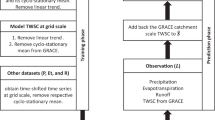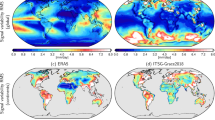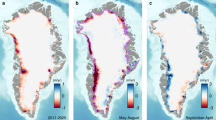Abstract
The wetness of a watershed determines its response to precipitation1,2,3, leading to variability in flood generation4. The importance of total water storage—which includes snow, surface water, soil moisture and groundwater—for the predisposition of a region to flooding is less clear, in part because such comprehensive observations are rarely available. Here we demonstrate that basin-scale estimates of water storage derived from satellite observations of time-variable gravity can be used to characterize regional flood potential and may ultimately result in longer lead times in flood warnings. We use a case study of the catastrophic 2011 Missouri River floods to establish a relationship between river discharge, as measured by gauge stations, and basin-wide water storage, as measured remotely by NASA’s Gravity Recovery and Climate Experiment (GRACE) mission. Applying a time-lagged autoregressive model of river discharge, we show that the inclusion of GRACE-based total water storage information allows us to assess the predisposition of a river basin to flooding as much as 5–11 months in advance. Additional case studies of flood events in the Columbia River and Indus River basins further illustrate that longer lead-time flood prediction requires accurate information on the complete hydrologic state of a river basin.
This is a preview of subscription content, access via your institution
Access options
Subscribe to this journal
Receive 12 print issues and online access
$259.00 per year
only $21.58 per issue
Buy this article
- Purchase on Springer Link
- Instant access to full article PDF
Prices may be subject to local taxes which are calculated during checkout




Similar content being viewed by others
References
Sayama, T., McDonnell, J. J., Dhakal, A. & Sullivan, K. How much water can a watershed store? Hydrol. Process. 25, 3899–3908 (2011).
Kirchner, J. W. Catchments as simple dynamical systems: Catchment characterization, rainfall-runoff modeling, and doing hydrology backwards. Wat. Resour. Res. 45, W02429 (2009).
Brutsaert, W. Long-term groundwater storage trends estimated from streamflow records: Climatic perspective. Wat. Resour. Res. 44, W02409 (2008).
Li, L. & Simonovic, S. P. System dynamics model for predicting floods from snowmelt in North American prairie watersheds. Hydrol. Process. 16, 2645–2666 (2002).
Beven, K. J. Rainfall-Runoff Modeling: The Primer 360 (John Wiley, 2001).
Horton, R. E. Surface Runoff Phenomena, Part 1. Analysis of the Hydrograph (Horton Hydrological Laboratory, Publication 101, Edward Bros, 1935).
Hall, F. R. Base flow recessions—A review. Wat. Resour. Res. 4, 973–983 (1968).
Appleby, V. C. Recession and the baseflow problem. Wat. Resour. Res. 6, 1398–1403 (1970).
Wetterhall, F. et al. Forecasters priorities for improving probabilistic flood forecasts. Hydrol. Earth Syst. Sci. Discuss. 10, 2215–2242 (2013).
Guo, Y., Liu, S. & Baetz, B. W. Probabilistic rainfall-runoff transformation considering both infiltration and saturation excess runoff generation processes. Wat. Resour. Res. 48, W06513 (2012).
Siccardi, F., Boni, G., Ferraris, L. & Rudari, R. A hydrometeorological approach for probabilistic flood forecast. J. Geophys. Res. 110, D05101 (2005).
Reager, J. T. & Famiglietti, J. S. Global terrestrial water storage capacity and flood potential using GRACE. Geophys. Res. Lett. 36, L23402 (2009).
Famigilietti, J. S. & Rodell, M. Water in the balance. Science 340, 1300 (2013).
Tapley, B. D., Bettadpur, S., Ries, J. C., Thompson, P. F. & Watkinse, M. M. GRACE measurements of mass variability in the Earth system. Science 305, 503–505 (2004).
Ramillien, G., Famiglietti, J. S. & Wahr, J. Detection of continental hydrology and glaciology signals from GRACE: A review. Surv. Geophys. 29, 361–374 (2008).
Syed, T. H., Famiglietti, J. S. & Chambers, D. GRACE-based estimates of terrestrial freshwater discharge from basin to continental scales. J. Hydromet. 10, 22–40 (2009).
Rodell, M., Velicogna, I. & Famiglietti, J. Satellite-based estimates of groundwater depletion in India. Nature 460, 999–1002 (2009).
Famiglietti, J. S. et al. Satellites measure recent rates of groundwater depletion in California’s Central Valley. Geophys. Res. Lett. 38, L03403 (2011).
Crowley, J. W., Mitrovica, J. X., Bailey, R. C., Tamisiea, M. E. & Davis, J. L. Land water storage within the Congo Basin inferred from GRACE satellite gravity data. Geophys. Res. Lett. 33, L19402 (2006).
Spring Flooding Underway, Expected to Worsen through April (NOAA news website, 2011); http://www.noaanews.noaa.gov/stories2011/20110317_springoutlook.html
US Army Corps of Engineers, Post 2011 Flood Event Analysis of Missouri River (USACE, 2012)
Swenson, S. & Wahr, J. Methods for inferring regional surface-mass anomalies from Gravity recovery and Climate Experiment (GRACE) measurements of time-variable gravity. J. Geophys. Res. 107, 2193 (2002).
Wahr, J., Swenson, S. & Velicogna, I. Accuracy of GRACE mass estimates. Geophys. Res. Lett. 33, L06401 (2006).
Advanced Hydrologic Prediction Service: Portland: Columbia River (NWS, 2011); http://water.weather.gov/ahps2/hydrograph.php?wfo=pqr&gage=vapw1
Natural Hazards: Unusually Intense Monsoon Rains (NASA Earth Observatory, 2010); http://earthobservatory.nasa.gov/NaturalHazards/view.php?id=45177
Rodell, M. et al. The global land data assimilation system. Bull. Am. Meteorol. Soc. 85, 381–394 (2004).
Acknowledgements
This work was supported by grants from the NASA GRACE Science Team, from the NASA Earth and Space Science Fellowship program, from the University of California Office of the President, Multicampus Research Programs and Initiatives, and from the Gordon and Betty Moore Foundation (GBMF3269). We offer a special thanks to S. Swenson of the National Center for Atmospheric Research for GRACE data processing and early discussion.
Author information
Authors and Affiliations
Contributions
J.T.R. and J.S.F. conceived the project; J.T.R. designed the study, performed the data analysis and wrote the manuscript; B.F.T. advised on methods and interpretation; B.F.T. and J.S.F. assisted in writing the manuscript.
Corresponding author
Ethics declarations
Competing interests
The authors declare no competing financial interests.
Supplementary information
Supplementary Information
Supplementary Information (PDF 5627 kb)
Rights and permissions
About this article
Cite this article
Reager, J., Thomas, B. & Famiglietti, J. River basin flood potential inferred using GRACE gravity observations at several months lead time. Nature Geosci 7, 588–592 (2014). https://doi.org/10.1038/ngeo2203
Received:
Accepted:
Published:
Issue Date:
DOI: https://doi.org/10.1038/ngeo2203
This article is cited by
-
Extreme flooding controlled by stream network organization and flow regime
Nature Geoscience (2023)
-
Estimating GRACE terrestrial water storage anomaly using an improved point mass solution
Scientific Data (2023)
-
Extreme local recycling of moisture via wetlands and forests in North-East Indian subcontinent: a Mini-Amazon
Scientific Reports (2023)
-
Water cycle science enabled by the GRACE and GRACE-FO satellite missions
Nature Water (2023)
-
Changing intensity of hydroclimatic extreme events revealed by GRACE and GRACE-FO
Nature Water (2023)



